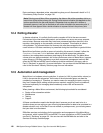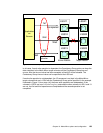136 IBM System Storage DS6000 Series: Copy Services with IBM System z
13.3 Consistency Group function
In order to restart applications at the remote site successfully, the remote site must have
consistent data. In normal operation, Metro Mirror keeps data consistency at the remote site.
However, as mentioned in 12.3, “Data consistency” on page 131 and in 12.4, “Rolling
disaster” on page 132, in case of a rolling disaster, a particular procedure is necessary to
keep data consistency even in a synchronous remote copy environment.
In this section we explain
data consistency and then explain how the Metro Mirror Consistency
Group function keeps data consistency at the remote site, in case of a rolling disaster.
13.3.1 Data consistency and dependent writes
Many applications, such as databases, process a repository of data that has been generated
over a period of time. Many of these applications require that the repository is in a
consistent
state in order to begin or continue processing. In general, consistency implies that the order
of
dependent writes is preserved in the data copy. In the Metro Mirror environment, keeping
data consistency means that the order of dependent writes is preserved in all the Metro Mirror
target volumes. For example, the following sequence occurs for a basic database operation
involving a log volume and a data volume:
1. Write to log volume: Data Record #2 is being updated.
2. Update Data Record #2 on data volume.
3. Write to log volume: Data Record #2 update complete.
If the copy of the data contains any of these combinations then the data is consistent:
Operations 1, 2, and 3
Operations 1 and 2
Operation 1
If the copy of data contains any of these combinations then the data is
inconsistent (the order
of dependent writes was
not preserved):
Operations 2 and 3
Operations 1 and 3
Operation 2
Operation 3
When discussing the Consistency Group function,
data consistency means this sequence is
always kept in the copied data. And the order of non-dependent writes does not necessarily
need to be preserved. For example, consider the following two sequences:
1. Deposit paycheck in checking account A.
2. Withdraw cash from checking account A.
3. Deposit paycheck in checking account B.
4. Withdraw cash from checking account B.
In order for the data to be consistent, the deposit of the paycheck must be applied
before the
withdrawal of cash for each of the checking accounts. However, it does not matter whether
the deposit to checking account A or checking account B occurred first, as long as the
associated withdrawals are in the correct order. So, for example, the data copy would be
consistent if the following sequence occurred at the copy:
1. Deposit paycheck in checking account B.
2. Deposit paycheck in checking account A.
3. Withdraw cash from checking account B.
4. WIthdraw cash from checking account A.


















